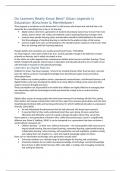Samenvatting
Summary Book and Articles EdPsy
This document contains all the literature prescribed for the test of Educational Psychology, so it should enable you to prepare well for the test! Since the test is in English, this summary is written in English as well. You might like to know that I passed the exam with an 8. Good luck learning an...
[Meer zien]














